

Compact Muon Solenoid
LHC, CERN
| CMS-PAS-HIG-18-026 | ||
| Search for the decay of the Higgs boson to a pair of light pseudoscalar bosons in the $ \mathrm{b\bar{b}b\bar{b}} $ final state in proton-proton collisions at 13 TeV | ||
| CMS Collaboration | ||
| 4 December 2023 | ||
| Abstract: A search is presented for the decay of the 125 GeV Higgs boson (H) to a pair of new light pseudoscalar bosons ($ \mathrm{a} $), followed by the prompt decay of each a boson to a bottom quark-antiquark pair, $ \mathrm{H} \rightarrow \mathrm{a}\mathrm{a} \rightarrow \mathrm{b}\bar{\mathrm{b}}\mathrm{b}\bar{\mathrm{b}} $. The analysis is performed using a data sample of proton-proton collisions collected with the CMS detector at a center-of-mass energy of 13 TeV, corresponding to an integrated luminosity of 138 fb$ ^{-1} $. To reduce the background from standard model processes, the search requires the Higgs boson to be produced in association with a leptonically decaying W or Z boson. The analysis is sensitive to the production of new light bosons in the 15 $ < \mathrm{m}_{\mathrm{a}} < $ 60 GeV mass range. Assuming the standard model cross sections for $ \mathrm{pp} \rightarrow \mathrm{WH} $ and $ \mathrm{ZH} $, with branching fractions $ \mathcal{B}(\mathrm{H} \rightarrow \mathrm{a}\mathrm{a})= $ 1 and $ \mathcal{B}(\mathrm{a} \rightarrow \mathrm{b}\bar{\mathrm{b}})= $ 1, masses of the a boson between 21 and 60 GeV are excluded. | ||
|
Links:
CDS record (PDF) ;
CADI line (restricted) ;
These preliminary results are superseded in this paper, Submitted to JHEP. The superseded preliminary plots can be found here. |
||
| Figures | |
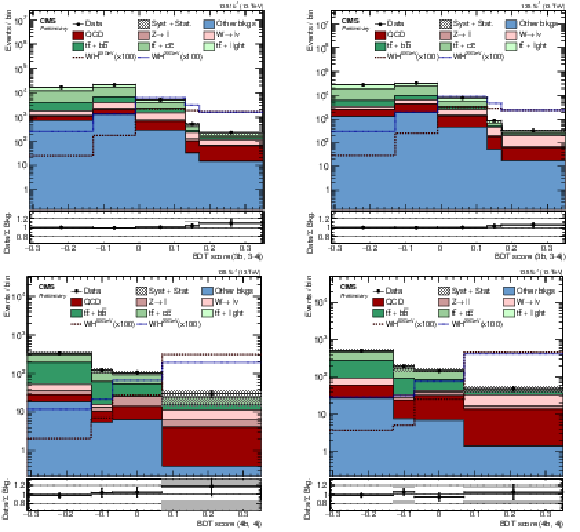
png pdf |
Figure 1:
Post-fit BDT distributions in the WH channel extracted with the $ m_{\mathrm{a}}= $ 60 GeV signal hypothesis. Signal regions for the 3b (upper) and 4b (lower) event categories are shown separately for the electron (left) and muon (right) channels. The $ m_{\mathrm{a}}= $ 60 GeV and $ m_{\mathrm{a}}= $ 20 GeV signal points are shown scaled by a factor of 100. The horizontal error bars indicate the bin width. |
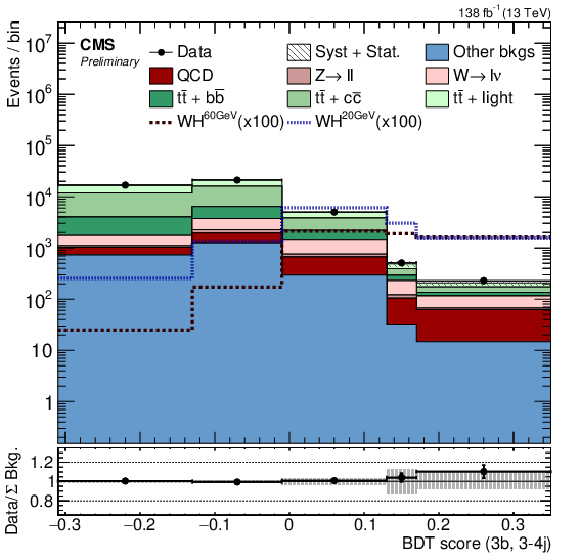
png pdf |
Figure 1-a:
Post-fit BDT distributions in the WH channel extracted with the $ m_{\mathrm{a}}= $ 60 GeV signal hypothesis. Signal regions for the 3b (upper) and 4b (lower) event categories are shown separately for the electron (left) and muon (right) channels. The $ m_{\mathrm{a}}= $ 60 GeV and $ m_{\mathrm{a}}= $ 20 GeV signal points are shown scaled by a factor of 100. The horizontal error bars indicate the bin width. |
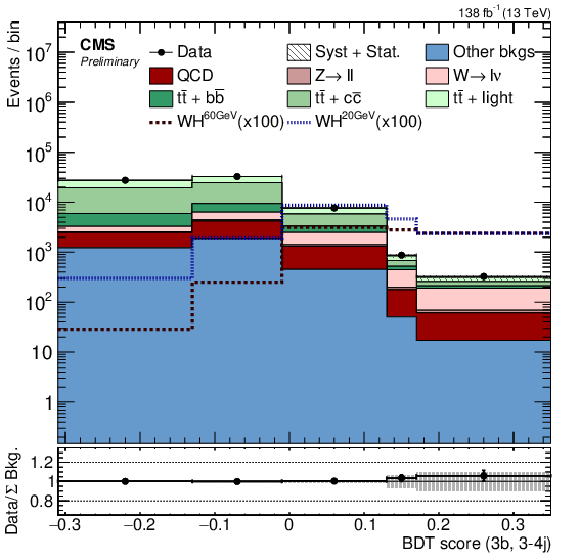
png pdf |
Figure 1-b:
Post-fit BDT distributions in the WH channel extracted with the $ m_{\mathrm{a}}= $ 60 GeV signal hypothesis. Signal regions for the 3b (upper) and 4b (lower) event categories are shown separately for the electron (left) and muon (right) channels. The $ m_{\mathrm{a}}= $ 60 GeV and $ m_{\mathrm{a}}= $ 20 GeV signal points are shown scaled by a factor of 100. The horizontal error bars indicate the bin width. |

png pdf |
Figure 1-c:
Post-fit BDT distributions in the WH channel extracted with the $ m_{\mathrm{a}}= $ 60 GeV signal hypothesis. Signal regions for the 3b (upper) and 4b (lower) event categories are shown separately for the electron (left) and muon (right) channels. The $ m_{\mathrm{a}}= $ 60 GeV and $ m_{\mathrm{a}}= $ 20 GeV signal points are shown scaled by a factor of 100. The horizontal error bars indicate the bin width. |
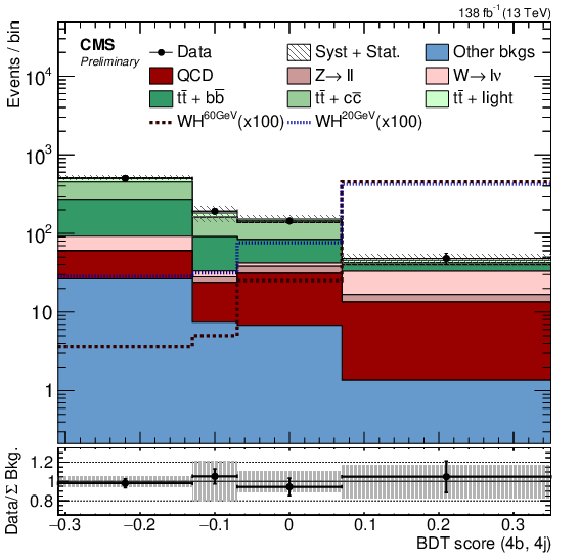
png pdf |
Figure 1-d:
Post-fit BDT distributions in the WH channel extracted with the $ m_{\mathrm{a}}= $ 60 GeV signal hypothesis. Signal regions for the 3b (upper) and 4b (lower) event categories are shown separately for the electron (left) and muon (right) channels. The $ m_{\mathrm{a}}= $ 60 GeV and $ m_{\mathrm{a}}= $ 20 GeV signal points are shown scaled by a factor of 100. The horizontal error bars indicate the bin width. |
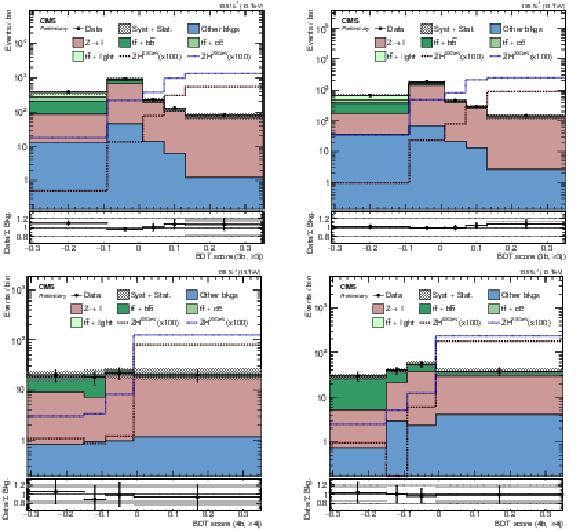
png pdf |
Figure 2:
Post-fit BDT distributions in the ZH channel extracted with the $ m_{\mathrm{a}}= $ 60 GeV signal hypothesis. Signal regions for the 3b (upper) and 4b (lower) event categories are shown separately for the electron (left) and muon (right) channels. The $ m_{\mathrm{a}}= $ 60 GeV and $ m_{\mathrm{a}}= $ 20 GeV signal points are shown scaled by a factor of 100. The horizontal error bars indicate the bin width. |

png pdf |
Figure 2-a:
Post-fit BDT distributions in the ZH channel extracted with the $ m_{\mathrm{a}}= $ 60 GeV signal hypothesis. Signal regions for the 3b (upper) and 4b (lower) event categories are shown separately for the electron (left) and muon (right) channels. The $ m_{\mathrm{a}}= $ 60 GeV and $ m_{\mathrm{a}}= $ 20 GeV signal points are shown scaled by a factor of 100. The horizontal error bars indicate the bin width. |
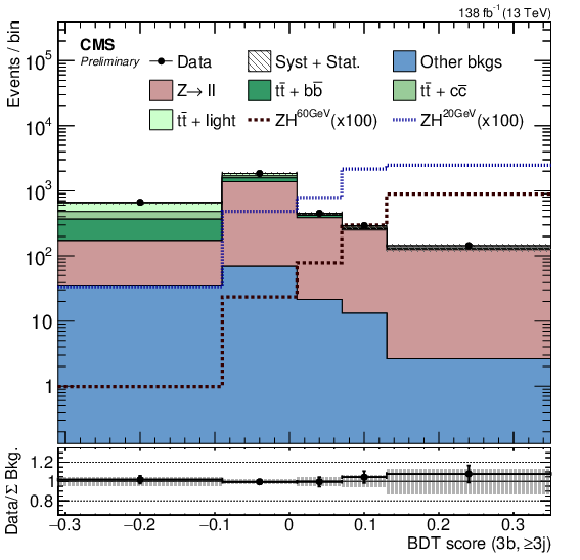
png pdf |
Figure 2-b:
Post-fit BDT distributions in the ZH channel extracted with the $ m_{\mathrm{a}}= $ 60 GeV signal hypothesis. Signal regions for the 3b (upper) and 4b (lower) event categories are shown separately for the electron (left) and muon (right) channels. The $ m_{\mathrm{a}}= $ 60 GeV and $ m_{\mathrm{a}}= $ 20 GeV signal points are shown scaled by a factor of 100. The horizontal error bars indicate the bin width. |

png pdf |
Figure 2-c:
Post-fit BDT distributions in the ZH channel extracted with the $ m_{\mathrm{a}}= $ 60 GeV signal hypothesis. Signal regions for the 3b (upper) and 4b (lower) event categories are shown separately for the electron (left) and muon (right) channels. The $ m_{\mathrm{a}}= $ 60 GeV and $ m_{\mathrm{a}}= $ 20 GeV signal points are shown scaled by a factor of 100. The horizontal error bars indicate the bin width. |
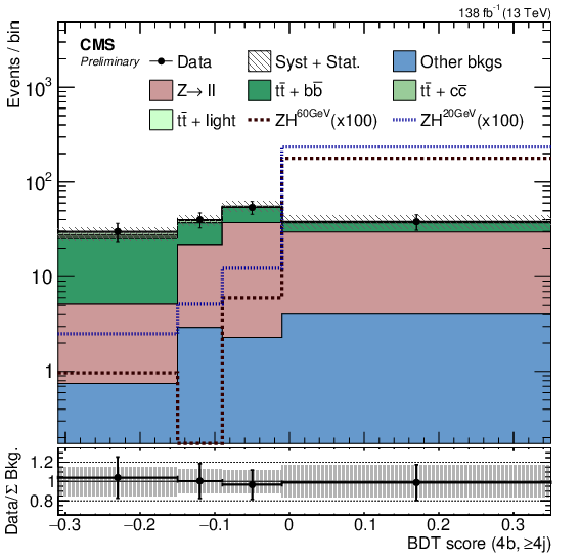
png pdf |
Figure 2-d:
Post-fit BDT distributions in the ZH channel extracted with the $ m_{\mathrm{a}}= $ 60 GeV signal hypothesis. Signal regions for the 3b (upper) and 4b (lower) event categories are shown separately for the electron (left) and muon (right) channels. The $ m_{\mathrm{a}}= $ 60 GeV and $ m_{\mathrm{a}}= $ 20 GeV signal points are shown scaled by a factor of 100. The horizontal error bars indicate the bin width. |

png pdf |
Figure 3:
Observed and expected limits on the signal strength $ \mu = \sigma(\mathrm{V}\mathrm{H}) \mathcal{B}(\mathrm{H}\to\mathrm{a}\mathrm{a}\to\mathrm{b}\overline{\mathrm{b}}\mathrm{b}\overline{\mathrm{b}}) / \sigma(\mathrm{V}\mathrm{H})_{\mathrm{SM}} $ in the WH (left) and ZH channel (right). The solid blue line indicates the SM cross section $ \sigma (\mathrm{p}\mathrm{p}\to\mathrm{V}\mathrm{H}) $ with branching fractions $ \mathcal{B}(\mathrm{H}\to\mathrm{a}\mathrm{a})= $ 1 and $ \mathcal{B}(\mathrm{a}\to\mathrm{b}\overline{\mathrm{b}})= $ 1.} |

png pdf |
Figure 3-a:
Observed and expected limits on the signal strength $ \mu = \sigma(\mathrm{V}\mathrm{H}) \mathcal{B}(\mathrm{H}\to\mathrm{a}\mathrm{a}\to\mathrm{b}\overline{\mathrm{b}}\mathrm{b}\overline{\mathrm{b}}) / \sigma(\mathrm{V}\mathrm{H})_{\mathrm{SM}} $ in the WH (left) and ZH channel (right). The solid blue line indicates the SM cross section $ \sigma (\mathrm{p}\mathrm{p}\to\mathrm{V}\mathrm{H}) $ with branching fractions $ \mathcal{B}(\mathrm{H}\to\mathrm{a}\mathrm{a})= $ 1 and $ \mathcal{B}(\mathrm{a}\to\mathrm{b}\overline{\mathrm{b}})= $ 1.} |
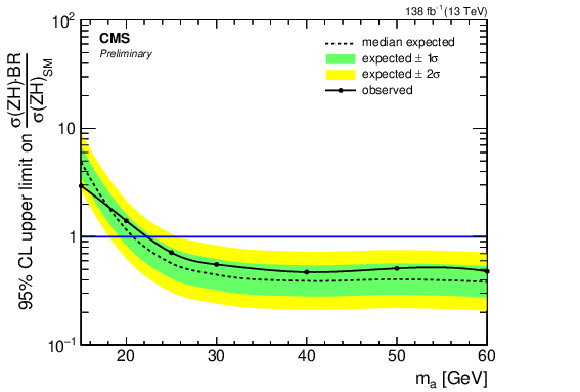
png pdf |
Figure 3-b:
Observed and expected limits on the signal strength $ \mu = \sigma(\mathrm{V}\mathrm{H}) \mathcal{B}(\mathrm{H}\to\mathrm{a}\mathrm{a}\to\mathrm{b}\overline{\mathrm{b}}\mathrm{b}\overline{\mathrm{b}}) / \sigma(\mathrm{V}\mathrm{H})_{\mathrm{SM}} $ in the WH (left) and ZH channel (right). The solid blue line indicates the SM cross section $ \sigma (\mathrm{p}\mathrm{p}\to\mathrm{V}\mathrm{H}) $ with branching fractions $ \mathcal{B}(\mathrm{H}\to\mathrm{a}\mathrm{a})= $ 1 and $ \mathcal{B}(\mathrm{a}\to\mathrm{b}\overline{\mathrm{b}})= $ 1.} |

png pdf |
Figure 4:
Observed and expected limits on the signal strength $ \mu = \sigma(\mathrm{V}\mathrm{H}) \mathcal{B}(\mathrm{H}\to\mathrm{a}\mathrm{a}\to\mathrm{b}\overline{\mathrm{b}}\mathrm{b}\overline{\mathrm{b}}) / \sigma(\mathrm{V}\mathrm{H})_{\mathrm{SM}} $ with the WH and ZH channels combined. The solid blue line indicates the SM cross section $ \sigma (\mathrm{p}\mathrm{p}\to\mathrm{V}\mathrm{H}) $ with branching fractions $ \mathcal{B}(\mathrm{H}\to\mathrm{a}\mathrm{a})= $ 1 and $ \mathcal{B}(\mathrm{a}\to\mathrm{b}\overline{\mathrm{b}})= $ 1. |
| Tables | |
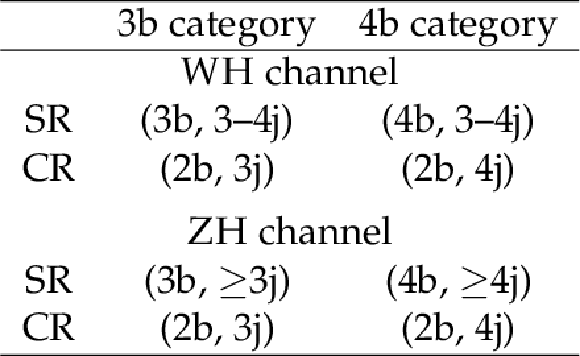
png pdf |
Table 1:
Signal region (SR) and control region (CR) requirements in ($ N_{\mathrm{b}} $, $ N_{\text{j}} $) for the WH and ZH channels, where $ N_{\mathrm{b}} $ is the number of b-tagged jets in an event and $ N_{\text{j}} $ is the total number of jets in an event. |

png pdf |
Table 2:
Summary of systematic uncertainties for background and signal event yields in the WH channel. Uncertainties that are negligible are indicated with a dash ($ \text{---} $). |

png pdf |
Table 3:
Summary of systematic uncertainties for background and signal event yields in the ZH channel. Uncertainties that are negligible are indicated with a dash ($ \text{---} $). |

png pdf |
Table 4:
Signal-plus-background fit results for the 3b WH and ZH signal regions extracted with the $ m_{\mathrm{a}}= $ 60 GeV signal hypothesis. The column header indicates the lepton flavor and the BDT bin range. Signal yields are shown for the $ m_{\mathrm{a}}= $ 20 and 60 GeV hypotheses. The background uncertainties account for both systematic and statistical sources. |
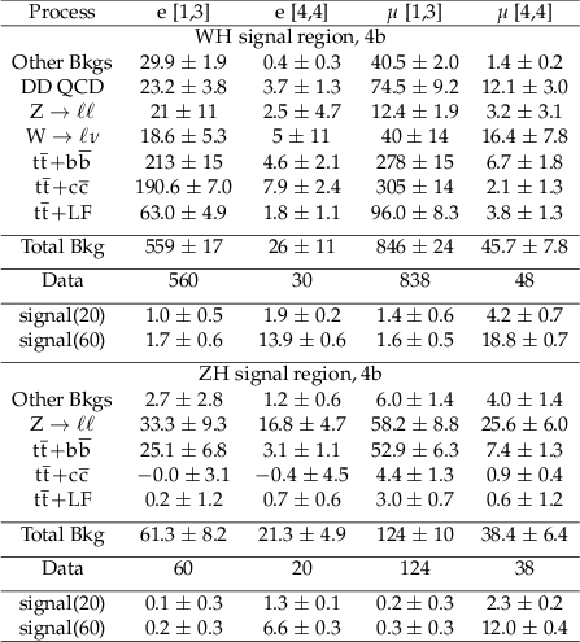
png pdf |
Table 5:
Signal-plus-background fit results for the 4b WH and ZH signal regions extracted with the $ m_{\mathrm{a}}=60\,\text{Ge\hspace{-.08em}V} $ signal hypothesis. The column header indicates the lepton flavor and the BDT bin range. Signal yields are shown for the $ m_{\mathrm{a}}= $ 20 and 60 GeV hypotheses. The background uncertainties account for both systematic and statistical sources. |
| Summary |
| A search for exotic decays of the 125 GeV Higgs boson (H) to a pair of new light pseudoscalar bosons $ \mathrm{a} $, followed by decay to four b quark jets, $ \mathrm{H}\to\mathrm{a}\mathrm{a}\to\mathrm{b}\overline{\mathrm{b}}\mathrm{b}\overline{\mathrm{b}} $, is presented, using data recorded with the CMS detector. The analysis is based on an integrated luminosity of 138 fb$^{-1}$ collected at a center-of-mass energy of 13 TeV in 2016--2018. The search is performed in the context of the associated WH and ZH production in which the W or Z boson decays leptonically, $ \mathrm{W}\to\ell\nu $ or $ \mathrm{Z}\to\ell^+\ell^- $, with $ \ell $ an electron or muon. No evidence for the targeted decay mode is observed. Upper limits at 95% confidence level on the signal strength of 0.360 (1.103) are obtained for a pseudoscalar boson mass of 60 (20) GeV, assuming the standard model cross sections $ \sigma (\mathrm{p}\mathrm{p}\to\mathrm{W}\mathrm{H}) = $ 1.37 pb and $ \sigma (\mathrm{p}\mathrm{p}\to\mathrm{Z}\mathrm{H}) = $ 0.86 pb, with branching fractions $ \mathcal{B}(\mathrm{H}\to\mathrm{a}\mathrm{a})= $ 1 and $ \mathcal{B}(\mathrm{a}\to\mathrm{b}\overline{\mathrm{b}})= $ 1. Masses of the $ \mathrm{a} $ boson between 21 and 60 GeV are excluded under the presumptions of the analysis. |
| References | ||||
| 1 | ATLAS Collaboration | Observation of a new particle in the search for the standard model Higgs boson with the ATLAS detector at the LHC | PLB 716 (2012) 1 | 1207.7214 |
| 2 | CMS Collaboration | Observation of a new boson at a mass of 125 GeV with the CMS experiment at the LHC | PLB 716 (2012) 30 | CMS-HIG-12-028 1207.7235 |
| 3 | CMS Collaboration | Observation of a new boson with mass near 125 GeV in pp collisions at $ \sqrt{s} $ = 7 and 8 TeV | JHEP 06 (2013) 081 | CMS-HIG-12-036 1303.4571 |
| 4 | ATLAS and CMS Collaborations | Measurements of the Higgs boson production and decay rates and constraints on its couplings from a combined ATLAS and CMS analysis of the LHC pp collision data at $ \sqrt{s}= $ 7 and 8 TeV | JHEP 08 (2016) 045 | 1606.02266 |
| 5 | ATLAS Collaboration | Combination of searches for invisible Higgs boson decays with the ATLAS experiment | PRL 122 (2019) 231801 | 1904.05105 |
| 6 | CMS Collaboration | Search for invisible decays of a Higgs boson produced through vector boson fusion in proton-proton collisions at $ \sqrt{s} = $ 13 TeV | PLB 793 (2019) 520 | CMS-HIG-17-023 1809.05937 |
| 7 | CMS Collaboration | Combined measurements of Higgs boson couplings in proton-proton collisions at $ \sqrt{s}= $ 13 TeV | EPJC 79 (2019) 421 | CMS-HIG-17-031 1809.10733 |
| 8 | G. C. Branco et al. | Theory and phenomenology of two-Higgs-doublet models | Phys. Rept. 516 (2012) 1 | 1106.0034 |
| 9 | D. Curtin et al. | Exotic decays of the 125 GeV Higgs boson | PRD 90 (2014) 075004 | 1312.4992 |
| 10 | U. Ellwanger, C. Hugonie, and A. M. Teixeira | The next-to-minimal supersymmetric standard model | Phys. Rept. 496 (2010) 1 | 0910.1785 |
| 11 | ATLAS Collaboration | Search for the Higgs boson produced in association with a $ W $ boson and decaying to four $ b $-quarks via two spin-zero particles in $ pp $ collisions at 13 TeV with the ATLAS detector | EPJC 76 (2016) 605 | 1606.08391 |
| 12 | ATLAS Collaboration | Search for the Higgs boson produced in association with a vector boson and decaying into two spin-zero particles in the $ H \rightarrow aa \rightarrow 4b $ channel in $ pp $ collisions at $ \sqrt{s} = $ 13 TeV with the ATLAS detector | JHEP 10 (2018) 031 | 1806.07355 |
| 13 | ATLAS Collaboration | Search for Higgs boson decays into two new low-mass spin-0 particles in the 4$ b $ channel with the ATLAS detector using $ pp $ collisions at $ \sqrt{s}= $ 13 TeV | PRD 102 (2020) 112006 | 2005.12236 |
| 14 | ATLAS Collaboration | Search for new light gauge bosons in Higgs boson decays to four-lepton final states in $ pp $ collisions at $ \sqrt{s}= $ 8 TeV with the ATLAS detector at the LHC | PRD 92 (2015) 092001 | 1505.07645 |
| 15 | CMS Collaboration | Search for a non-standard-model Higgs boson decaying to a pair of new light bosons in four-muon final states | PLB 726 (2013) 564 | CMS-EXO-12-012 1210.7619 |
| 16 | CMS Collaboration | A search for pair production of new light bosons decaying into muons | PLB 752 (2016) 146 | CMS-HIG-13-010 1506.00424 |
| 17 | CMS Collaboration | Search for light bosons in decays of the 125 GeV Higgs boson in proton-proton collisions at $ \sqrt{s}= $ 8 TeV | JHEP 10 (2017) 076 | CMS-HIG-16-015 1701.02032 |
| 18 | CMS Collaboration | Search for a very light NMSSM Higgs boson produced in decays of the 125 GeV scalar boson and decaying into $ \tau $ leptons in pp collisions at $ \sqrt{s}= $ 8 TeV | JHEP 01 (2016) 079 | CMS-HIG-14-019 1510.06534 |
| 19 | ATLAS Collaboration | Search for new phenomena in events with at least three photons collected in $ pp $ collisions at $ \sqrt{s} $ = 8 TeV with the ATLAS detector | EPJC 76 (2016) 210 | 1509.05051 |
| 20 | ATLAS Collaboration | Search for Higgs boson decays to beyond-the-standard-model light bosons in four-lepton events with the ATLAS detector at $ \sqrt{s}= $ 13 TeV | JHEP 06 (2018) 166 | 1802.03388 |
| 21 | CMS Collaboration | A search for pair production of new light bosons decaying into muons in proton-proton collisions at 13 TeV | PLB 796 (2019) 131 | CMS-HIG-18-003 1812.00380 |
| 22 | ATLAS Collaboration | Search for Higgs bosons decaying to aa in the $ \mu\mu\tau\tau $ final state in pp collisions at $ \sqrt{s} = $ 8 TeV with the ATLAS experiment | PRD 92 (2015) 052002 | 1505.01609 |
| 23 | CMS Collaboration | Search for an exotic decay of the Higgs boson to a pair of light pseudoscalars in the final state of two muons and two $ \tau $ leptons in proton-proton collisions at $ \sqrt{s}= $ 13 TeV | JHEP 11 (2018) 018 | CMS-HIG-17-029 1805.04865 |
| 24 | ATLAS Collaboration | Search for Higgs boson decays into a pair of light bosons in the $ bb\mu\mu $ final state in $ pp $ collision at $ \sqrt{s} = $13 TeV with the ATLAS detector | PLB 790 (2019) 1 | 1807.00539 |
| 25 | CMS Collaboration | Search for an exotic decay of the Higgs boson to a pair of light pseudoscalars in the final state with two b quarks and two $ \tau $ leptons in proton-proton collisions at $ \sqrt{s}= $ 13 TeV | PLB 785 (2018) 462 | CMS-HIG-17-024 1805.10191 |
| 26 | ATLAS Collaboration | Search for Higgs boson decays into pairs of light (pseudo)scalar particles in the $ \gamma\gamma jj $ final state in pp collisions at $ \sqrt{s}= $ 13 TeV with the ATLAS detector | PLB 782 (2018) 750 | 1803.11145 |
| 27 | CMS Collaboration | The CMS experiment at the CERN LHC | JINST 3 (2008) S08004 | |
| 28 | CMS Collaboration | The CMS trigger system | JINST 12 (2017) P01020 | CMS-TRG-12-001 1609.02366 |
| 29 | P. Nason | A new method for combining NLO QCD with shower Monte Carlo algorithms | JHEP 11 (2004) 040 | hep-ph/0409146 |
| 30 | S. Frixione, P. Nason, and C. Oleari | Matching NLO QCD computations with parton shower simulations: the POWHEG method | JHEP 11 (2007) 070 | 0709.2092 |
| 31 | S. Alioli, P. Nason, C. Oleari, and E. Re | A general framework for implementing NLO calculations in shower Monte Carlo programs: the POWHEG BOX | JHEP 06 (2010) 043 | 1002.2581 |
| 32 | J. Alwall et al. | The automated computation of tree-level and next-to-leading order differential cross sections, and their matching to parton shower simulations | JHEP 07 (2014) 079 | 1405.0301 |
| 33 | J. Alwall et al. | Comparative study of various algorithms for the merging of parton showers and matrix elements in hadronic collisions | --500, 2008 EPJC 53 (2008) 473 |
0706.2569 |
| 34 | R. Frederix and S. Frixione | Merging meets matching in MC@NLO | JHEP 12 (2012) 061 | 1209.6215 |
| 35 | LHC Higgs Cross Section Working Group | Handbook of LHC Higgs cross sections: 1. Inclusive observables | CERN, 2011 link |
1101.0593 |
| 36 | LHC Higgs Cross Section Working Group | Handbook of LHC Higgs cross sections: 2. Differential distributions | CERN, 2012 link |
1201.3084 |
| 37 | LHC Higgs Cross Section Working Group Collaboration | Handbook of LHC Higgs cross sections: 3. Higgs properties | CERN, 2013 link |
1307.1347 |
| 38 | LHC Higgs Cross Section Working Group | Handbook of LHC Higgs cross sections: 4. deciphering the nature of the Higgs sector | link | 1610.07922 |
| 39 | NNPDF Collaboration | Parton distributions for the LHC run II | JHEP 04 (2015) 040 | 1410.8849 |
| 40 | P. Skands, S. Carrazza, and J. Rojo | Tuning PYTHIA 8.1: the Monash 2013 Tune | EPJC 74 (2014) 3024 | 1404.5630 |
| 41 | CMS Collaboration | Event generator tunes obtained from underlying event and multiparton scattering measurements | EPJC 76 (2016) 155 | CMS-GEN-14-001 1512.00815 |
| 42 | GEANT4 Collaboration | GEANT 4---a simulation toolkit | NIM A 506 (2003) 250 | |
| 43 | CMS Collaboration | Technical proposal for the Phase-II upgrade of the Compact Muon Solenoid | CMS Technical Proposal CERN-LHCC-2015-010, CMS-TDR-15-02, 2015 CDS |
|
| 44 | CMS Collaboration | Particle-flow reconstruction and global event description with the CMS detector | JINST 12 (2017) P10003 | CMS-PRF-14-001 1706.04965 |
| 45 | CMS Collaboration | Performance of the CMS muon detector and muon reconstruction with proton-proton collisions at $ \sqrt{s}= $ 13 TeV | JINST 13 (2018) P06015 | CMS-MUO-16-001 1804.04528 |
| 46 | CMS Collaboration | Performance of electron reconstruction and selection with the CMS detector in proton-proton collisions at $ \sqrt{s} = $ 8 TeV | JINST 10 (2015) P06005 | CMS-EGM-13-001 1502.02701 |
| 47 | M. Cacciari and G. P. Salam | Pileup subtraction using jet areas | PLB 659 (2008) 119 | 0707.1378 |
| 48 | M. Cacciari, G. P. Salam, and G. Soyez | The anti-$ k_{\mathrm{T}} $ jet clustering algorithm | JHEP 04 (2008) 063 | 0802.1189 |
| 49 | M. Cacciari, G. P. Salam, and G. Soyez | FastJet user manual | EPJC 72 (2012) 1896 | 1111.6097 |
| 50 | CMS Collaboration | Jet energy scale and resolution in the CMS experiment in pp collisions at 8 TeV | JINST 12 (2017) P02014 | CMS-JME-13-004 1607.03663 |
| 51 | CMS Collaboration | Identification of heavy-flavour jets with the CMS detector in pp collisions at 13 TeV | JINST 13 (2018) P05011 | CMS-BTV-16-002 1712.07158 |
| 52 | CMS Collaboration | Performance of missing transverse momentum reconstruction in proton-proton collisions at $ \sqrt{s} = $ 13 TeV using the CMS detector | JINST 14 (2019) P07004 | CMS-JME-17-001 1903.06078 |
| 53 | UA1 Collaboration | Experimental observation of isolated large transverse energy electrons with associated missing energy at $ \sqrt{s} = $ 540 GeV | PLB 122 (1983) 103 | |
| 54 | H. Voss, A. Höcker, J. Stelzer, and F. Tegenfeldt | TMVA, the toolkit for multivariate data analysis with ROOT | in XIth International Workshop on Advanced Computing and Analysis Techniques in Physics Research (ACAT), 2007 [PoS(ACAT)040] |
physics/0703039 |
| 55 | ATLAS Collaboration | Measurement of differential production cross-sections for a $ Z $ boson in association with $ b $-jets in 7 TeV proton-proton collisions with the ATLAS detector | JHEP 10 (2014) 141 | 1407.3643 |
| 56 | CMS Collaboration | Measurement of the associated production of a $ Z $ boson with charm or bottom quark jets in proton-proton collisions at $ \sqrt {s} $=13 TeV | no.~3, 03, 2020 PRD 102 (2020) |
CMS-SMP-19-004 2001.06899 |
| 57 | CMS Collaboration | CMS luminosity measurements for the 2016 data taking period | CMS Physics Analysis Summary, 2017 CMS-PAS-LUM-17-001 |
CMS-PAS-LUM-17-001 |
| 58 | CMS Collaboration | CMS luminosity measurement for the 2017 data-taking period at $ \sqrt{s} = $ 13 TeV | CMS Physics Analysis Summary, 2018 CMS-PAS-LUM-17-004 |
CMS-PAS-LUM-17-004 |
| 59 | CMS Collaboration | CMS luminosity measurement for the 2018 data-taking period at $ \sqrt{s}= $ 13 TeV | CMS Physics Analysis Summary, 2019 CMS-PAS-LUM-18-002 |
CMS-PAS-LUM-18-002 |
| 60 | J. Butterworth et al. | PDF4LHC recommendations for LHC Run II | JPG 43 (2016) 023001 | 1510.03865 |
| 61 | CMS Collaboration | Measurement of the inelastic proton-proton cross section at $ \sqrt{s}= $ 13 TeV | JHEP 07 (2018) 161 | CMS-FSQ-15-005 1802.02613 |
| 62 | CMS Collaboration | Measurement of the associated production of a Z boson with charm or bottom quark jets in proton-proton collisions at $ \sqrt{s}= $ 13 TeV | Submitted to PRD, 2020 | CMS-SMP-19-004 2001.06899 |

|
Compact Muon Solenoid LHC, CERN |

|

|

|

|

|

|